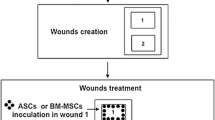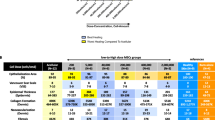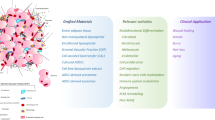Abstract
To explore the feasibility of repairing clinical cutaneous deficiency, autogenic bone marrow mesenchymal stem cells (BMSCs) were isolated and differentiated into epidermal cells and fibroblasts in vitro supplemented with different inducing factors and biomaterials to construct functional tissueengineered skin. The results showed that after 72 h induction, BMSCs displayed morphologic changes such as typical epidermal cell arrangement, from spindle shape to round or oval; tonofibrils, melanosomes and keratohyaline granules were observed under a transmission electronic microscope. The differentiated cells expressed epidermal stem cell surface marker CK19 (59.66% ± 4.2%) and epidermal cells differentiation marker CK10. In addition, the induced epidermal cells acquired the anti-radiation capacity featured by lowered apoptosis following exposure to UVB. On the other hand, the collagen microfibrils deposition was noticed under a transmission electronic microscope after differentiating into dermis fibroblasts; RT-PCR identified collagen type I mRNA expression in differentiated cells; radioimmunoassay detected the secretion of interleukin-6 (IL-6) and interleukin-8 (IL-8) (up to 115.06 pg/mL and 0.84 ng/mL, respectively). Further in vivo implanting BMSCs with scaffold material shortened skin wound repair significantly. In one word, autogenic BMSCs have the potential to differentiate into epidermal cells and fibroblasts in vitro, and show clinical feasibility acting as epidermis-like and dermis-like seed cells in skin engineering.
Similar content being viewed by others
References
Pittenger M F, Mackay A M, Beek S C, et al. Multilineage potential of adult human mesenchymal stem cells. Science, 1999, 284: 143–147
Robert J D, Annemarie B M. Mesenchymal stem cells: Biology and potential clinical uses. Exp Hemato, 2000, 28: 875–884
David J A, Fred H G, Irving L W. Can stem cells cross the lineage boundaries? Nat Med, 2001, 7: 393–395
Timothy R B, Fabio MVR, Gilmor L K, et al. From marrow to brain: Expression of neuronal phenotypes in adult mice. Science, 2000, 290: 1775–1779
Nakagawa H, Akita S, Fukui M, et al. Human mesenchymal stem cells successfully improve skin-substitute wound healing. Br J Dermatol, 2005, 153: 29–36
Fang L J, Fu X B, Sun T Z, et al. The initial observation of differentiation into epidermal cells in vivo of human bone marrow mesenchymal stem cells. Chinese J Traumatol, 2003, 19: 212–214
Hou L L, Cao H, Bai C X, et al. The experimental research of proliferation and differentiation into nerve cells in vitro of human bone marrow mesenchymal stem cells. Chin Sci Bull, 2002, 47: 277–281
Kulms D, Zcisc E. DNA damage, death receptor activation and reactive oxygen species contribute to ultraviolet radiation-induced apoptosis in an essential and independent way. Oncogene, 2002, 21: 5844–5851
Kulms D, Schwarz T. Independent contribution of three different pathways to ultraviolet-B-induced apoptosis. Biochem Pharmacol, 2002, 64: 837–841
Assefaa Z, Van Laethem A, Garmyn M, et al. Ultraviolet radiation-induced apoptosis in keratinocytes: On the role of cytosolic factors. Biochim Biophys Acta, 2005, 1755: 90–106
Canguihem B, Pradines A, Baudouin C, et al. RhoB Protects human keratinocytes from UVB-induced apoptosis through epidermal growth factor receptor signaling. J Biol Chem, 2005, 280: 43257–43263
Kuhn C, Hurwitz S A. Activation of the insulin-like growth factor-1 receptor promotes the survival of human keratinocytes following ultraviolet B irradiation. Int J Cancer, 1999, 80: 431–438
Decraene D, Agostinis P, Bouillon R, et al. Insulin-like growth factor-1-mediated AKT activation postopones the onset of ultraviolet B-induced apoptosis, providing more time for cyclobutane thymine dimer removal in primary human keratinocytes. J Biol Chem, 2002, 277:32587–32595
Cheng J, Grande J P. Transforming growth factor beta signal transduction and progressive renal disease. Exp Biol Med, 2002, 227: 943–956
Mori Y, Chen S J, Varga J. Modulation of endogenous Smad expression in normal skin fibroblasts by transforming growth factor. Exp Cell Res, 2000, 258: 374–383
Masatoshi J, Hironobu I. α2(I) collagen gene regulation by protein kinase C signaling in human dermal fibroblasts. Nucleic Acids Research, 2005, 33: 1337–1351
Lin Z Q, Kondo T, Ishida Y, et al. Essential involvement of IL-6 in the skin wound-healing process as evidenced by delayed wound healing in IL-6-deficient mice. J Leukoc Biol, 2003, 73: 713–721
Gallucci R M, Sloan D K, IIeck J M, et al. Interleukin 6 indirectly induces keratinocyte migration. J Invest Dermatol, 2004, 122: 764–772
Wang X P, Schunck M, Kallen K J, et al. The interleukin-6 cytokine system regulates epidermal permeability barrier homeostasis. J Invest Dermatol, 2004, 123: 124–131
Mackenzie T C, Flake A W. Human mesenchymal stem cells persist demonstrate site-specific multipotential differentiation and are present in sites of wound healing and tissue regeneration after transplantation into fetal sheep. Blood Cells Mol Dis, 2001, 27: 601–604
Author information
Authors and Affiliations
Corresponding author
Additional information
Supported by the Major Technology Program of Beijing Municipal Science & Technology Commission (Grant No. H060920050130) and the Major State Basic Research Development Program of China (Grant No. 2005CB522702)
Rights and permissions
About this article
Cite this article
He, L., Nan, X., Wang, Y. et al. Full-thickness tissue engineered skin constructed with autogenic bone marrow mesenchymal stem cells. SCI CHINA SER C 50, 429–437 (2007). https://doi.org/10.1007/s11427-007-0069-2
Received:
Accepted:
Issue Date:
DOI: https://doi.org/10.1007/s11427-007-0069-2




